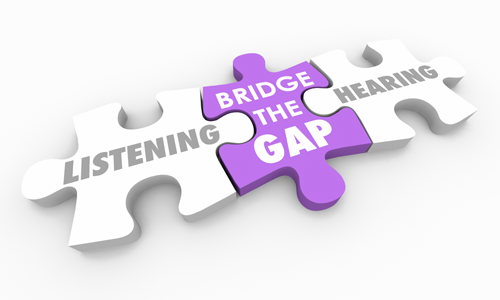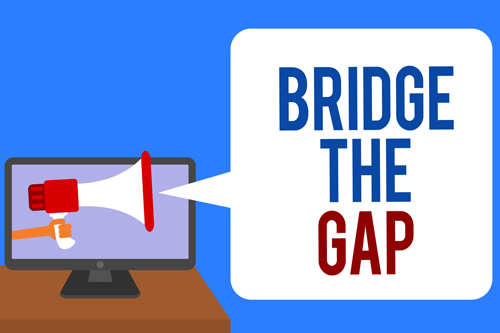While working as an educational assistant, I helped a fourth-grade student struggling with math. As we worked on problems, sometimes this student complained, “Why did they have to change math?!” I could picture an adult in his life griping in a similar way while trying to help their son at home. As I worked with him, his teacher began explaining an approach to multiplication I had never seen before. As I watched her demonstrate this new technique, I couldn’t help but wonder how much it would help the student if his parents could see what we see in the classroom. How much would it help this student if the parents could reinforce this concept at home, helping him practice these new methods as part of his homework, instead of lamenting the old way we used to do math?
Bridging the gap between home and school is vital to student success.
Each year, visitors bravely cross the famous Capilano Bridge located near Vancouver, British Columbia, Canada. This simple suspension bridge stretches 450 feet across Capilano Canyon and sits 230 feet above the Capilano River. Simple suspension bridges are held up entirely by anchors on both sides with no middle supports. The spectacular views, thrilling footsteps, and admirable design of the Capilano Bridge attract over 80,000 tourists each year.
As educators, establishing solid foundational anchors and cables from your side of the gap will encourage a reciprocal move on the homefront—bridging the gap between learning at home and at school. Just as tourists flock each year to marvel at the Capilano Bridge, your school community will establish a reputation for strong home-school communication. One of the best ways to reach out to parents is through teacher sites.
Teacher Sites: What They Are and What They Offer
Just as school websites provide necessary information to homes on a school level, teacher websites achieve the same on a classroom level in a personalized, professional way.
A teacher’s ability to communicate successfully with families is critical to the success of both the students and your school. School Webmasters offers a simple teacher website platform that is an excellent tool for home-school communication.
All teachers are a little different, and so are their communications methods—and that’s what makes teacher sites so fun! From themes and layouts to photo galleries and calendars, teacher websites are designed to suit the needs of every class. Designed to be user-friendly and simple to update, teacher websites from School Webmasters make it possible for teachers to:
- Post homework
- Display lesson plans
- Publish class schedules
- Communicate with students and parents
- Share news and announcements
- Display photos
- Provide resource links
- Create a class calendar
Also, you can coordinate teachers sites at your school with your school or district site design if purchased along with School Webmasters’ websites—coordination that helps strengthen your school brand.
Great teacher sites are an important and effective school public relations tool. We’ve heard many times that parents don’t care about the overall school or district—just about the classes their students are in. In fact, the best teacher sites help bridge the gap between the information parents want and their perception of your school. Let’s look at a few ways teacher sites provide added support to the bridge between home and school communication.
Great Teacher Sites Help Bridge the Gap to Understanding Concepts
Each classroom is different. Each teacher is different and prefers various approaches, methods, and tools. Regardless, students need support both from home and from their educators at school. Therefore, underlying concepts should be communicated home to better help students succeed. Teacher sites are a great place to share teaching methods and complex concepts.
There are a variety of ways your school can do this. For example, many elementary schools have motivational programs encouraging young students to read regularly, master sight words, and master math facts. Like you, I have seen firsthand how these core capacities are essential to student success. Once they accomplish those key elements, they enjoy a smoother transition into each additional layer of education as they progress through the school year and each grade level.
In contrast, if they struggle with core concepts, they are hindered; they fall behind quickly. Many times, teachers explain programs and curriculum to parents at the beginning of the year during Back to School nights or in the middle of the year at events like curriculum nights. While these approaches are important, often parents and caregivers can struggle to fully grasp important details or methods from infrequent exposure shared once or twice during the school year. With five children of my own, ranging from elementary to high school, I can attest to this wholeheartedly. Finding ways to send important conceptual information to parents and caregivers in a way they can understand (and on their own time) can greatly benefit your students.
When your teachers use teacher websites to share concepts, they can look at the overall class and their needs. What would they like their students to better understand? How could parents support the students in their understanding? Perhaps teachers could include a video on their teacher website explaining a math concept. Or, perhaps providing a link to a Khan Academy video could help parents and caregivers as they encourage the students at home to do their math homework.
Ridgefield Public Schools recognized the need to help parents understand the ways they are teaching literacy and math, so they hosted a “Let’s Play School” afternoon. With the help of the PTA and the school math and literacy specialists, parents learned the same techniques their children were learning. Because this event took place during the day, the school knew not all parents would be able to attend, so they asked their School Webmasters’ communication coordinator to attend and film the event. The communications coordinator created a video and posted it to the district’s YouTube channel, which allowed parents with students at all the elementary schools in the district to see and learn for themselves as well.
The benefit of this type of communication is significant, and with the access we have to technology, it’s easy to reach students and parents in their homes in creative ways. Consider the ease of access to this kind of school communication: no matter when teachers add videos and other forms of instruction to their websites, parents can access it throughout the school year.
Salman Khan, founder of Khan Academy, explains the benefits of teaching via video and its timeless benefits in his Ted Talk. Using videos differs from Back to School nights and other events that parents may not attend, therefore missing the instruction. Not so with videos. They are accessible anytime, anywhere. It saves the teacher time and energy, yet the gift of knowledge is available over and over again, and the gap to understanding concepts is overcome.

Great Teacher Sites Help Bridge the Gap to Fostering Correct Principles
Teachers are a critical foundation of your school. All of the teachers at your school or in your district seek to educate their students through various ways and means. As they strive to do so, they are your boots on the ground for school marketing, and school branding. Consider these questions:
- How is your school vision shared with students and their families on a daily basis?
- What is your school community’s impression of your current school climate?
- Is your community satisfied with the experience they receive from your schools?
- How do you establish unspoken evidence of your school or district’s mission?
- Do you share inspiring stories regularly with your students and families?
- How often does this happen?
- How do you seek parent input with the challenges you face such as with behavior or even technology?
Perhaps your school incorporates Positive Behavioral Interventions and Supports (PBIS). Its purpose is to promote a school climate where appropriate behavior is the norm. Home behavior is crucial to reinforcing those behaviors. In this way and others, how do the classrooms in your school model what is important to you? How can you better educate all parents about the importance of supporting their children in doing their homework? As you open the door to parents and caregivers through various ways such as teacher websites, you are helping, encouraging, and expecting them to see and understand the importance and benefits of your school’s core values. As you do so, you build a stronger school community. You market your school. As teachers consistently share this vision through their teacher websites, home becomes an additional “classroom” of your school, bridging the gap to fostering correct principles.

Great Teacher Sites Help Bridge the Gap to Individualized, Streamlined Communication
It can be difficult to make space for the school communication needs of everything going on in your district or at your school. For high school students, there is a multitude of enrichment opportunities available to many, as well as other opportunities available to only a certain few. Club meetings, test prep classes, game schedules, internships, and scholarship opportunities.
How do you send certain communication out? What do your teachers wish their students’ families could understand? Good teacher websites can help communicate individual classroom needs. When communication is personalized, rather than sending out mass communications to the whole school, parents and caregivers notice this personalized approach, and they will be grateful for a school that tries to personalize messages. Whether your district or school is large or small, urban or rural, choosing to use teacher websites to communicate various types of information contributes to successful parent-teacher communication.

When it comes to education, the communication gap between school and home can often feel like an intimidating, deep gorge like Capilano Canyon. Communication across the divide for the benefit of the student can be difficult. Particularly when support from home is lacking in various ways, the path your students travel for the sake of their education can seem treacherous and precarious. Not everything makes it across the divide.
Teachers teach students principles, give them homework, and send communications home, encouraging home involvement. Parents and other caregivers, earnestly seeking to provide for the basic needs of the students, don’t often have enough time in the day to do much more. How often do your students receive instruction and information and successfully carry it home to their families? Do your students’ parents and caregivers understand the educational jargon used in teacher feedback and parent-teacher conferences? All of this effort is for the benefit of the student, now and in the long run. So, consider how your school could improve via minor adjustments, renovating or strengthening anchors and cables in your figurative bridges to homes around your school community.
As educators and parents together commit to Improve communication, the home-school communication gap is overcome. The bridge between home and school becomes safer and more stable. The educational journey of each student is successful.
Emily Boyle, School Content Specialist








